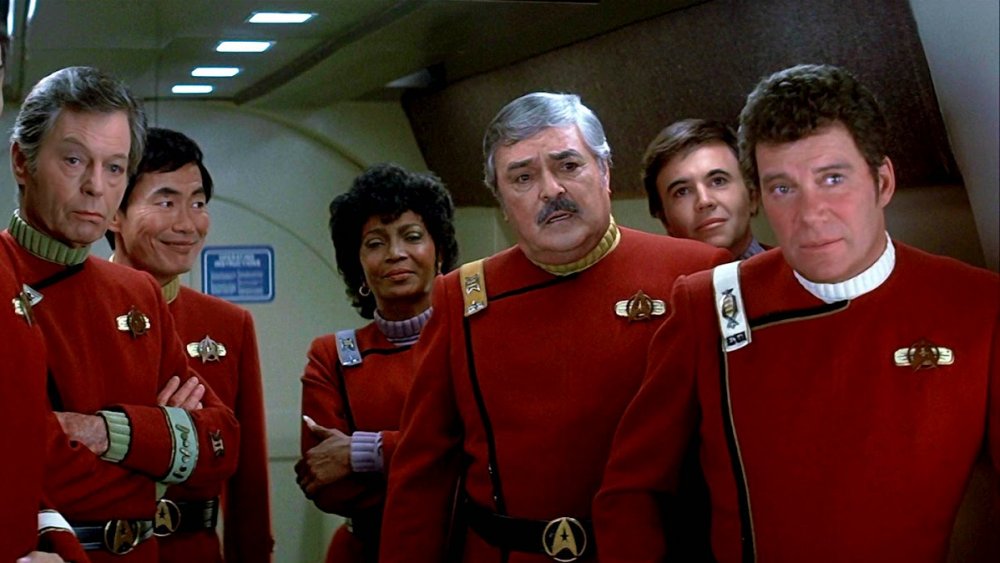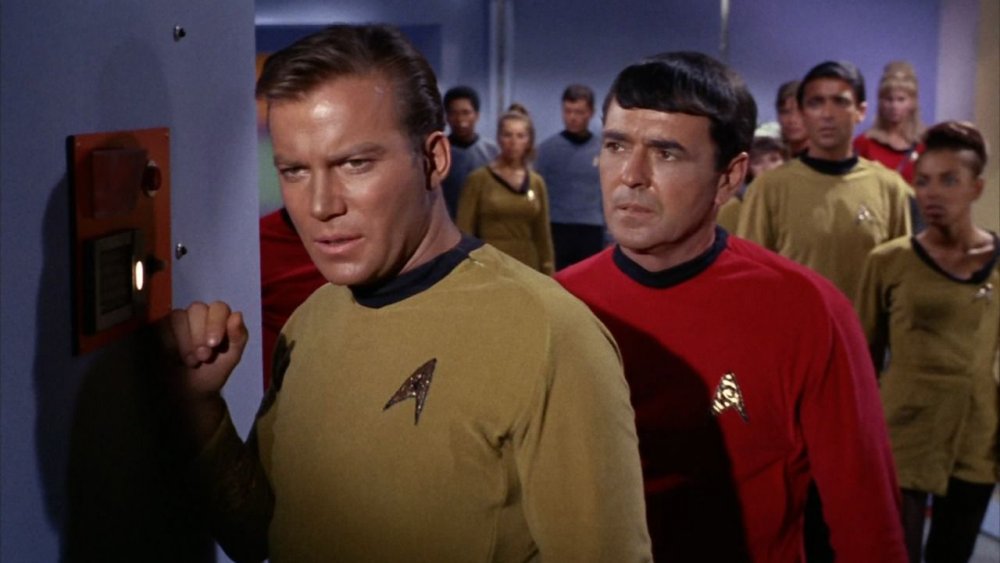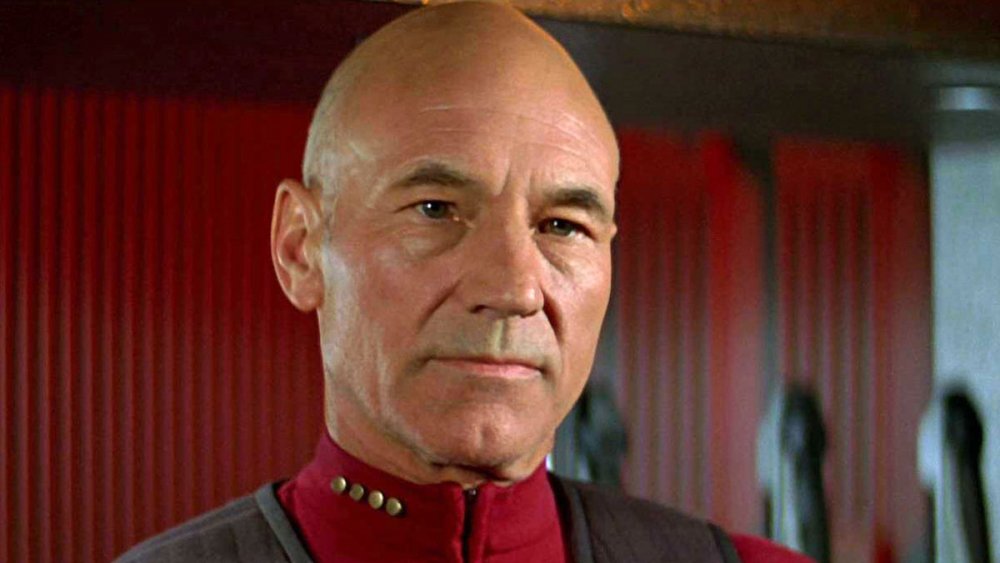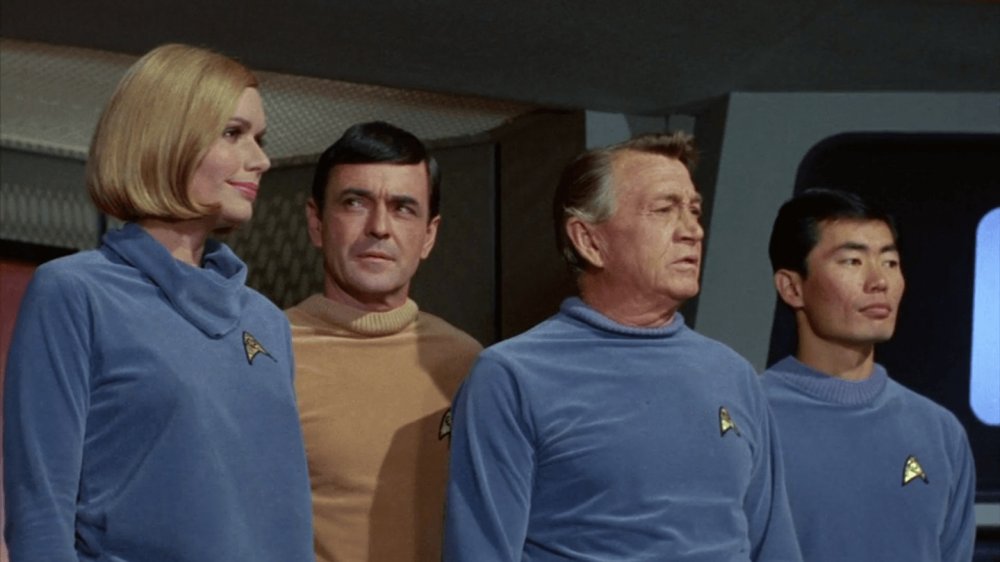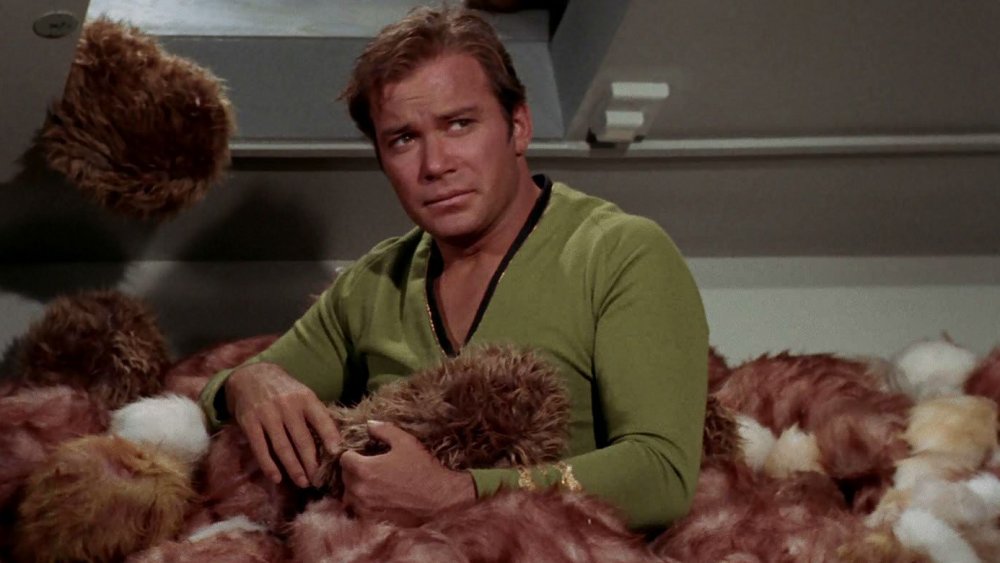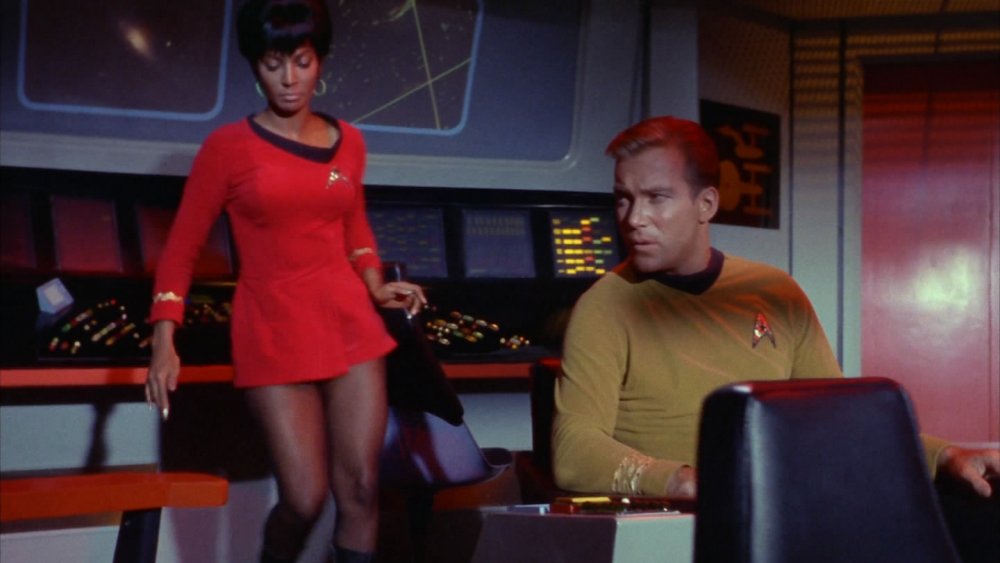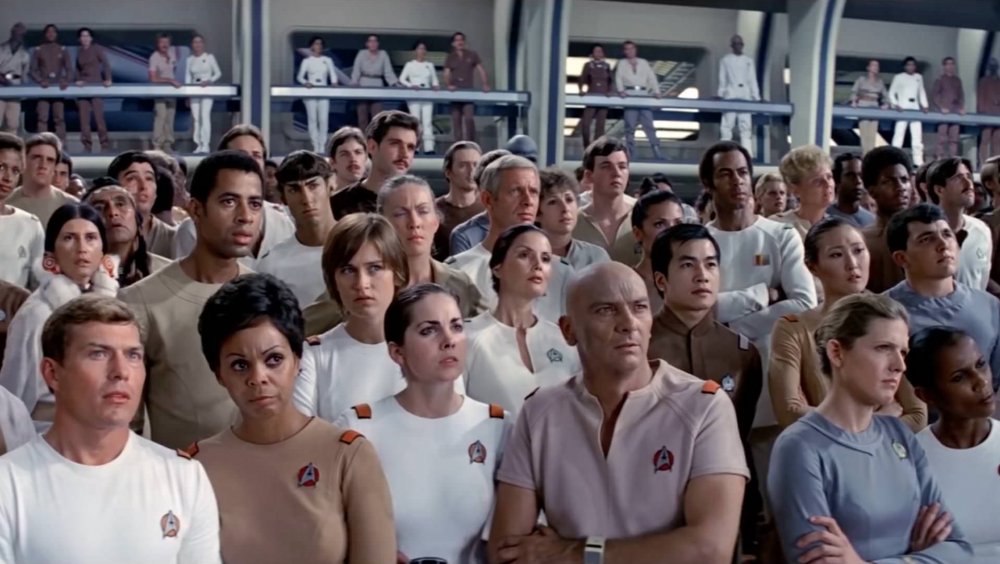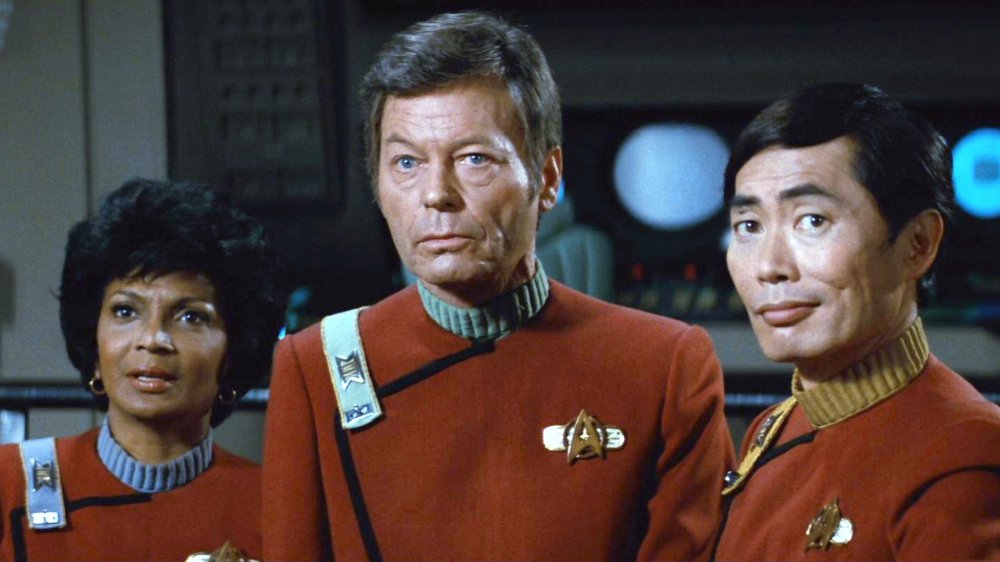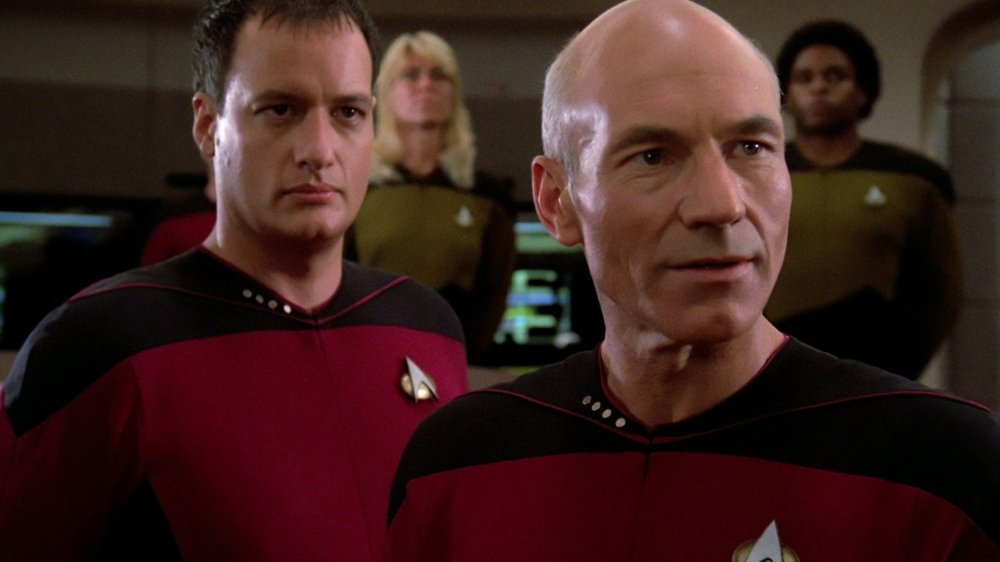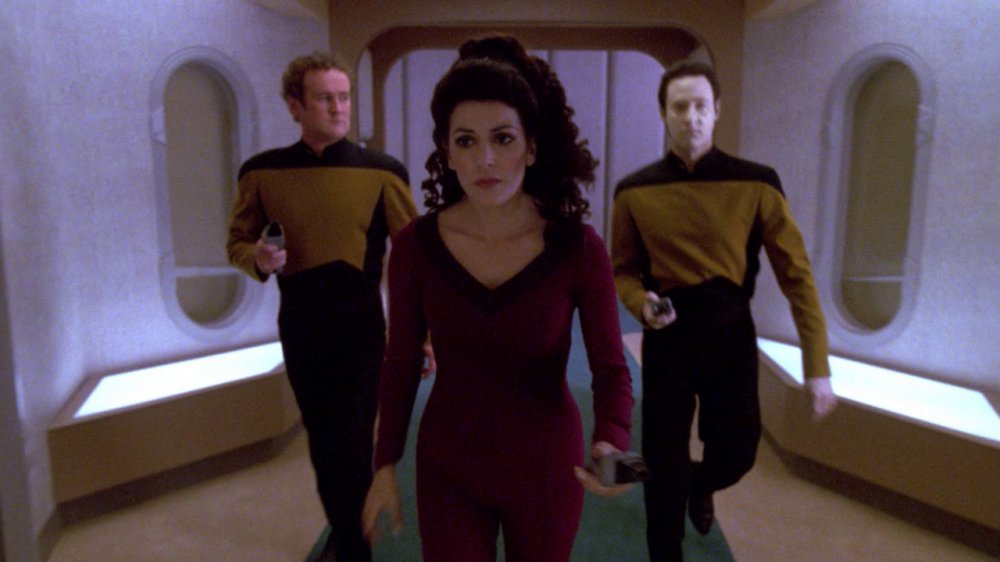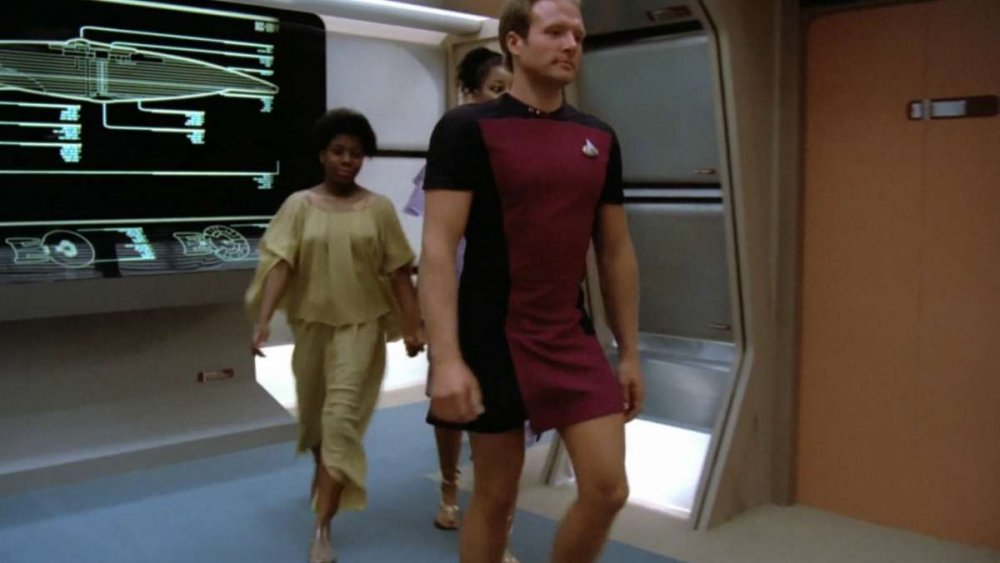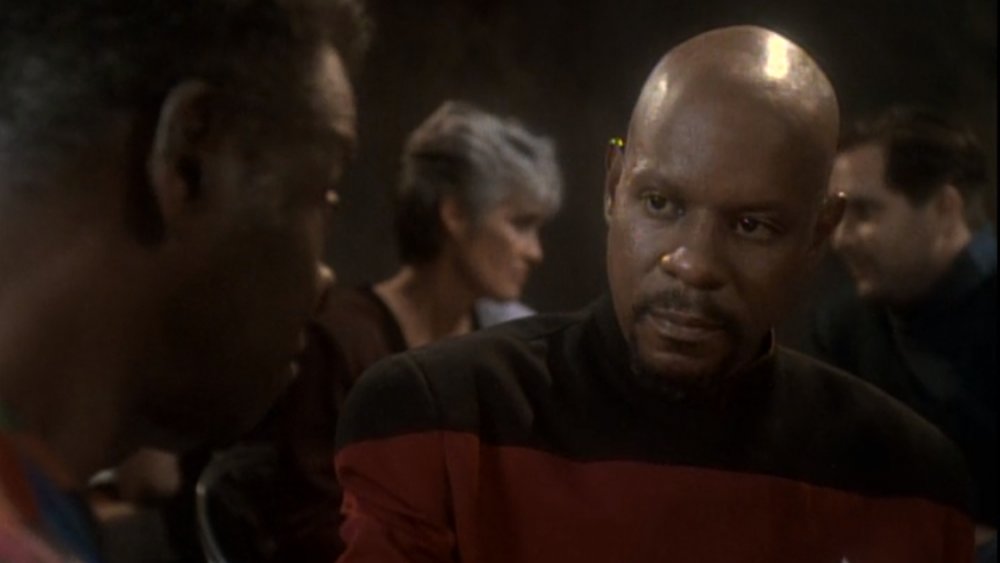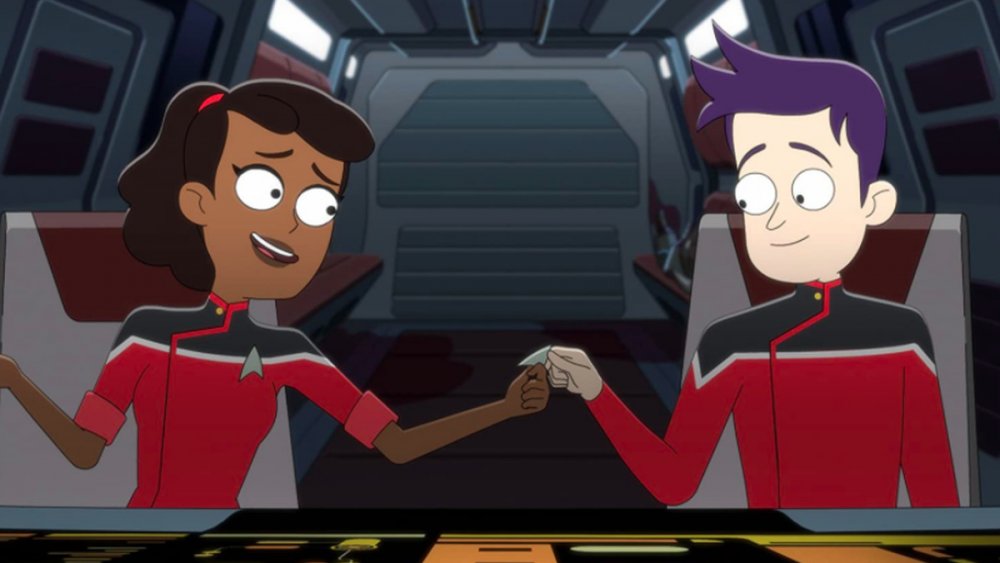Star Trek Uniforms Fully Explained
Since its premiere more than 50 years ago, Star Trek has been at the center of a growing web of culture, television, film, and fandom. With nine television series and 13 films, with undoubtedly more to come, there is a wealth of material to analyze and enjoy. Today, an enthusiastic fan can take just a single aspect of the Star Trek universe and dive into it for weeks.
Take uniforms. A seemingly simple concept, right? Star Trek generally focuses on the experiences of people serving in Starfleet, essentially a futuristic version of the Navy in space. So, Starfleet uniforms should be fairly consistent, even boring. Everyone's supposed to look like a cohesive group, so there should be little variation.
However, the uniforms of Star Trek are so varied and connected to the intricate fictional world of the franchise that it's pretty fascinating. Someone appearing on Star Trek: The Next Generation and then showing up again in a film like Star Trek: First Contact will probably have to fit themselves into two very distinct outfits. With more than five decades of stuff to go through, says CNET, there's a dizzying variety of looks for what's supposed to be a pretty staid quasi-military organization.
Practically everything about the history of Star Trek uniforms is linked to behind-the-scenes stories, real-world creativity, in-universe drama, and even a touch of fashion history here and there. From color, to cut, to material, there's a lot to learn.
Color is key to Star Trek uniforms
In Star Trek: The Original Series, which ran from 1966 to 1969, you can't miss the brightly hued uniform shirts sported by the crew of the starship Enterprise. Captain James T. Kirk and other members of the command staff sport golden yellow tops, says Mental Floss. Blue is reserved for the science department and medical personnel, so you'll see it on Mr. Spock, the second-in-command, and the ship's physician, Doctor McCoy.
And what of the folk in red uniforms? According to Star Trek lore, these poor "redshirts" are little more than cannon fodder, though, officially, red is for communications, admin, and security. If you're watching an episode where a random, red-clad crewmember is asked to beam down to the planet with the main cast, don't get too attached. They're probably going to get zapped, eaten, or otherwise annihilated to further the episode's plot.
Of course, there are some exceptions. Statistically speaking, says Nerdist, redshirts are not that bad off. Consider also that red shirts adorn major characters like Scotty, the ship's chief engineer, who made it through the entire series.
Now that you've got that settled, remember that it's only good for one series. In later Star Trek shows, red and gold switched places. Captains like The Next Generation's Jean-Luc Picard wore a dark red, while his security chief, Worf, wore gold.
Starfleet rank is shown by pips and stripes
Like so many real-world military organizations, Starfleet hinges on rank. Crewmembers are expected to follow orders, but on starships that can carry thousands of people, who are they supposed to take seriously? That's where the rickrack comes in.
In Star Trek: The Original Series, rank was denoted by stripes of gold ribbon on someone's sleeves. The more stripes, the higher the rank. Generally speaking, says Atlas Obscura, two or three stripes means a captain. Commissioned officers are a safe bet for one stripe. Non-commissioned people get either a bit of braid or nothing at all. The stripes were brought back for the reboot films beginning in 2009.
The follow up series, Star Trek: The Next Generation went for something different during its 1987 – 1994 run. The colors became a more muted, and the old rank stripes, which, frankly, looked like something you might have picked up from your local craft store, were retired. In their place, officers wore "pips," subtle little pins, on their collars. The higher someone's rank, the more pips they sported.
Other films played around a bit with the rank symbols, like the different colors and badges shown in 1982's Star Trek II: The Wrath of Khan. Still, they weren't too off the original mark. Generally speaking, the more junk on someone's uniform, the more likely it is that you'll have to follow their orders.
The original series went for velour
Futurama's Zapp Brannigan character, a send-up of Captain Kirk, is all about his velour uniform. The first Star Trek series really was into luxurious velour, too, but the fabric proved challenging to maintain. It's not as if the 1960s were known for comfortable natural materials, after all.
According to Esquire, the fabric initially used in Star Trek: The Original Series was a little flashy. Costume designers used a stretch cotton velour for the tops, with a black synthetic Dacron infused with sparkles for the pants. Both materials were meant to subtly glitter under studio lights, lending the uniforms a shimmery, 23rd-century, spacefaring feel.
Unfortunately, the velour was a flop. Many called it "that rotten velour," noting that the fabric tended to shrink in the wash and could tear easily. In the third and final season, designers substituted it for a double-knit nylon, says CNET, which proved to be a much hardier fabric, especially when it got thrown into the washing machine.
Captain Kirk's special green shirt was a little embarrassing
Originally, reports Atlas Obscura, the command staff of Star Trek: The Original Series was supposed to be sporting a muted green. Under the studio lights, though, the cameras read the green velour as a golden yellow. The production team simply went with it for the rest of the series.
Careful observers of the 1960s run will note that Captain Kirk is sometimes seen in a very green tunic-style shirt. According to an interview with series costume designer Bill Theiss, that's because it was made out of a different material. That particular shirt looked genuinely green. This is also why some of the colors in the original series seem to change, said Theiss. Even the miniature of the Enterprise could appear ever so slightly green under the right conditions.
William Shatner, the Canadian actor who played Kirk, wasn't necessarily fond of the tightly wrapped look, says Cinemablend. "It was a little embarrassing after lunch to have that tight green thing on you," he said.
Star Trek's women went from pants to miniskirts
The first pilot episode of Star Trek: The Original Series, "The Cage" is an odd duck. Though it was shot in 1964, it didn't make it to screens in its complete form until a Betamax release in 1989. Bits of the story were included in the season one two-parter "The Menagerie," but it contained only the briefest glimpses of what might have been.
These included things like a smiling Spock, different uniforms, and a woman in command wearing pants. Star Trek: The Original Series is notorious for its gendered uniforms. The men wore pants and long-sleeved shirts. Female crewmembers were confined to miniskirts so short that Lieutenant Uhura, the communications officer, always seemed on the verge of an embarrassing situation when she sat down.
That's partially why Number One, the second-in-command in "The Cage," stands out: She's wearing pants. Number One, played by Majel Barrett, is also a daring commander. But she wasn't considered right for the character. When Star Trek got its second pilot, none of the women were in command, and certainly none of them wore pants. Barrett returned, albeit as the emotional, mini-skirted Nurse Chapel.
Nichelle Nichols, who played Uhura, offers up a counterpoint. "I was wearing [miniskirts] on the street," she told the BBC. "What's wrong with wearing them on the air? [...] It was the era of the miniskirt. Everybody wore miniskirts."
The first Star Trek movie shook took uniforms in a weird direction
Star Trek: The Motion Picture looked like it was going to be a big deal. The 1979 film was the first time that fans would get to see their beloved crew on the big screen. Anticipation was high. Then, the movie debuted.
It landed with a dull thud. While die-hard fans still got enjoyment out of Star Trek's film debut, most viewers couldn't get past the plodding story and dialogue-heavy scenes. It made just enough profit to justify a sequel, to be sure. SyFy contends that The Motion Picture did originate some interesting new trends for the franchise, like wearable communicators and redesigned Klingons. Still, few would point to this entry as their favorite Star Trek movie.
Some of the blame surely lies with the redesigned uniforms. Where The Original Series had colorful, if somewhat cartoonish togs for the crew, The Motion Picture made it look like everyone was going to the weirdest slumber party ever. According to Memory Alpha, the crew was now outfitted in two-piece tunics and one-piece jumpsuits in mind-numbing shades like pale blue and beige. At least the women on the crew were dressed in the same jumpsuits worn by the men. They might have looked oddly dull for space adventurers, but crewmembers like Lt. Uhura didn't look like they needed to worry about errant breezes. And, if nothing else, the space pajamas look pretty comfortable.
The Wrath of Khan redeemed Star Trek uniforms while cutting costs
Though Star Trek: The Motion Picture began the series tradition of changing Starfleet uniforms at every opportunity, rebooted uniforms didn't get very eye-catching until the second film. In Star Trek: The Wrath of Khan, both the plotting and the uniforms got a much-needed upgrade.
To be fair, the striking red jackets of The Wrath of Khan wouldn't have existed as we know them if it weren't for the beige jumpsuits of The Motion Picture. As revealed by Empire, costume designer Robert Fletcher, burned somewhat by his experiences on the first film, decided to stay on in an attempt to redeem his craft. Fletcher still had to work within budget, says Forgotten Trek. Indeed, the budget was smaller, since the studio had been spooked somewhat by the lackluster performance of the first motion picture. As a result, Fletcher rather cleverly utilized the old movie uniforms. His team dyed the tunics red because that was the shade that took best to the fabric.
Meanwhile, Fletcher added a few more militaristic details to the revamped uniforms, like boxy shoulders, stripes, and shiny rank insignia. Fletch referred to it as "Hornblower in outer space," referring to the popular Horatio Hornblower series, set in the era of the Napoleonic Wars. The maroon color proved so successful that it persisted far beyond the film and back onto television with the follow-up series, Star Trek: The Next Generation.
Star Trek: The Next Generation's uniform was all about spandex
While the uniforms debuted in Star Trek: The Wrath of Khan were structured, boxy outfits inspired by military getups, the theme wasn't going to last, for William Ware Theiss, who designed the costumes for Star Trek: The Original Series, was ready to completely revamp even his own designs. Theiss was called upon to design the costumes for the first year of Star Trek: The Next Generation, the follow-up series that premiered in 1987. According to Forgotten Trek, Theiss wanted to pull back from the structured look of Wrath of Khan and return to a softer appearance.
That meant spandex. Specifically, Theiss employed a heavyweight material, of the type often used for swimsuits. He also changed the color scheme, making red the color for command staff, while gold was switched to engineering and security. Blue remained the key shade for medical and science personnel.
While designers might have liked the spandex, it got poor reviews from the actors. The form-fitting material was unforgiving of a heavy lunch or brief dalliance with a slice of cake. Robert Blackman, who replaced Theiss in later seasons, came to the rescue with a different cut and wool fabric. Unfortunately, only the male actors got the best changes, like two-piece uniforms. Female actors like Marina Sirtis, who played Counselor Troi, were stuck in uncomfortable one-piece jumpsuits for a while longer.
Deanna Troi's exception confused Trek fans
In Star Trek: The Next Generation, ship's counselor Deanna Troi was actually a Starfleet officer, but you wouldn't know it from her clothes. While everyone else on staff was wearing the regulation Starfleet uniform, Troi was often stuck in revealing onesies that recalled the first film's unfortunate jumpsuits.
It may have something to do with Troi's gender. As quoted at Forgotten Trek, Marina Sirtis, who played Troi, took a dim view of how the show treated female characters. "The women on this show are very non-threatening," she said. "You don't see women in power positions." Troi was meant to be a soft, caring therapist. Perhaps her clothing was meant to reflect that gentleness, but with an admittedly sexist twist that lowered her necklines and kept Sirtis trapped in revealing spandex for much longer than her coworkers. Too often, her clothes reflected stories where Troi was made to be helpless or even outright dull for the sake of the plot.
Counselor Troi finally got to wear the real uniform in "Chain of Command, Part 1," a season six two-parter. In it, Captain Jellico, an uptight fill-in for Captain Picard, curtly tells Troi to just wear the uniform already. While the impetus for the wardrobe change might have been embarrassing for her character, Sirtis was delighted. As she told the BBC, "I was thrilled when I got my regulation Starfleet uniform [...] I got all my brains back."
The "skant" tried to reach gender equality but fell flat
We should give Gene Roddenberry some credit. While he was often of his time for things like scantily clad secondary characters on Star Trek: The Original Series, he genuinely tried to push back against cultural assumptions. Sometimes, it worked and became practically legendary, as when he helped to create a diverse bridge crew on the first television series. Other times, he pushed for costume parity that simply didn't land.
Roddenberry was involved with the production of Star Trek: The Next Generation from its 1987 premiere until shortly before his death in 1991. He was part of almost everything in the series, including the costume design. As reported by Star Trek.com, Roddenberry directed designer William Ware Theiss to design what became known as the "skant."
This take on the minidress was made out of the same spandex as the other uniforms. It was also meant to be unisex. Crewmembers of any gender would be able to wear the thigh-baring skant. Yet, it was a hard sell. The skant was ever-so-briefly seen on a male crewmember here and there in the first season, says SyFy, but never after that. Female crew like Counselor Troi wore it a bit longer, but actors and viewers alike thought it just made her look like a space cheerleader. Though you can understand what Roddenberry and company were going for, the skant just couldn't stay. It faded into fan lore and obscurity soon after the first season.
Star Trek: Deep Space Nine made the uniforms fit for actual work
Star Trek didn't stop with Star Trek: The Next Generation. The sequel series was followed up by a progression of films and further television series. These included Star Trek: Deep Space Nine, which premiered in 1993 and briefly ran concurrently with The Next Generation. Though both series are supposed to take place at roughly the same time, the uniforms seen on Deep Space Nine were a serious departure.
Costume designer Robert Blackman returned to the jumpsuit design but mercifully stayed clear of figure-hugging, back-breaking spandex, says Forgotten Trek. Instead, the looser jumpsuits were made out of wool. Blackman had, like earlier designers, discovered that wool took dye better than other fabrics and held up to repeated washings.
The softer uniforms looked like they could exist in a real, workaday reality. Characters like Chief O'Brien can be seen in the bowels of Deep Space Nine, a scrappy space station inherited from its previous Cardassian occupants. His jumpsuit, based in part on a mechanic's outfit and NASA workaday gear, looks right at place in the more gritty, realistic world of Deep Space Nine.
Star Trek: Lower Decks brings back color and might explain a big mystery
Star Trek: Lower Decks is an animated comedy series, the first ever to take a look at the ridiculous side of Star Trek. While it's very definitely a silly take on the franchise, the Lower Decks series actually holds a clue to the ever-changing and seemingly inconsistent uniforms across the series.
In part, the uniforms of Lower Decks are an homage to a never-used 1994 redesign. According to Trek Movie, creator Mike McMahan realized the discarded uniform design for the Star Trek: Generations movie was just right for his series. It calls back to The Next Generation just enough to make connections but remains distinct and colorful in its new two-dimensional context.
This latest series might also help explain the constantly shifting Starfleet uniforms. Careful viewers may have already noticed that different ship and station crews sport wildly different looks, even when they're supposed to be taking place at the same time.
Inverse points out the apparent fact that Starfleet uniforms seem to correspond to very specific ships and jobs. Someone sent to a space station like Deep Space Nine would wear one uniform, while another crewmember on Picard's Enterprise would sport something noticeably different. An outside viewer could still see they were Starfleet personnel but might correctly guess they were stationed in different places. The looks on Lower Decks, which are their own unique creations, add more evidence to support this theory.
